PARENTING AND FAMILY ISSUES
VerifiedAdded on 2021/04/21
|7
|1472
|96
AI Summary
The assignment details explain Bronfenbrenner's ecological system theory and its relevance to child growth and development. It highlights the importance of socialization in shaping a child's behavior and cognitive status. The four methods of socialization - selective exposure, modeling, identification, and positive reinforcement - are discussed in detail. The assignment also references various studies and research papers on the topic.
Contribute Materials
Your contribution can guide someone’s learning journey. Share your
documents today.
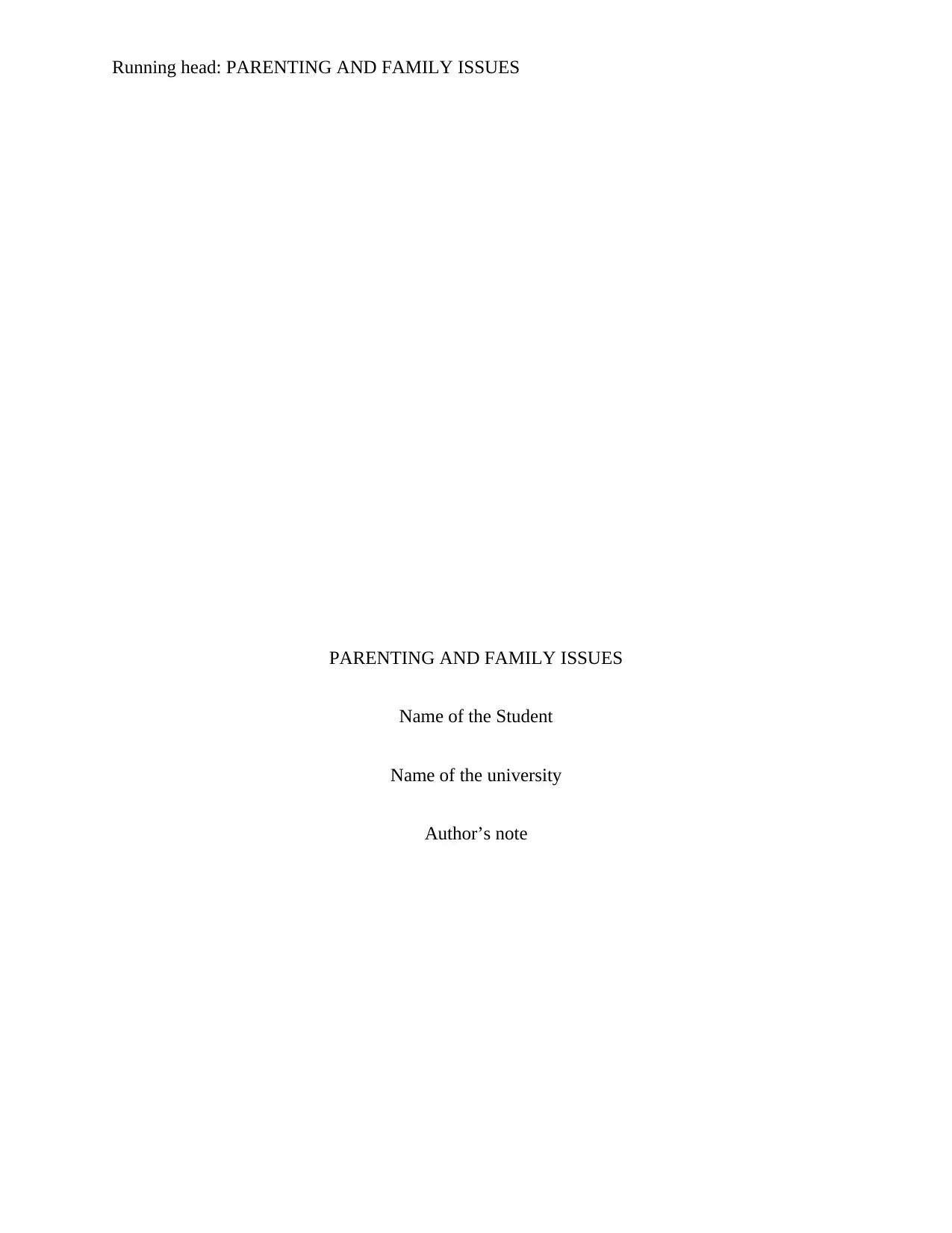
Running head: PARENTING AND FAMILY ISSUES
PARENTING AND FAMILY ISSUES
Name of the Student
Name of the university
Author’s note
PARENTING AND FAMILY ISSUES
Name of the Student
Name of the university
Author’s note
Secure Best Marks with AI Grader
Need help grading? Try our AI Grader for instant feedback on your assignments.
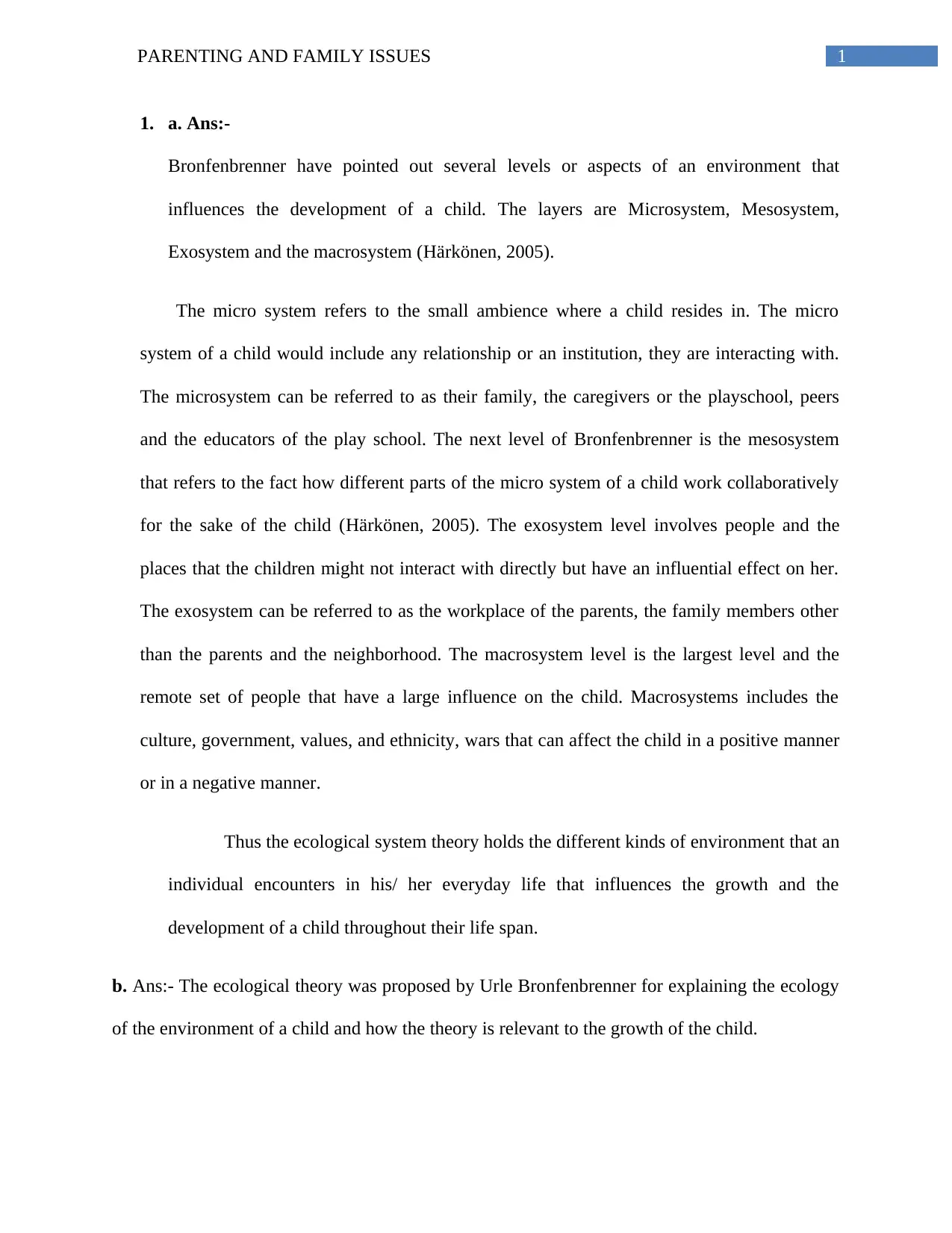
1PARENTING AND FAMILY ISSUES
1. a. Ans:-
Bronfenbrenner have pointed out several levels or aspects of an environment that
influences the development of a child. The layers are Microsystem, Mesosystem,
Exosystem and the macrosystem (Härkönen, 2005).
The micro system refers to the small ambience where a child resides in. The micro
system of a child would include any relationship or an institution, they are interacting with.
The microsystem can be referred to as their family, the caregivers or the playschool, peers
and the educators of the play school. The next level of Bronfenbrenner is the mesosystem
that refers to the fact how different parts of the micro system of a child work collaboratively
for the sake of the child (Härkönen, 2005). The exosystem level involves people and the
places that the children might not interact with directly but have an influential effect on her.
The exosystem can be referred to as the workplace of the parents, the family members other
than the parents and the neighborhood. The macrosystem level is the largest level and the
remote set of people that have a large influence on the child. Macrosystems includes the
culture, government, values, and ethnicity, wars that can affect the child in a positive manner
or in a negative manner.
Thus the ecological system theory holds the different kinds of environment that an
individual encounters in his/ her everyday life that influences the growth and the
development of a child throughout their life span.
b. Ans:- The ecological theory was proposed by Urle Bronfenbrenner for explaining the ecology
of the environment of a child and how the theory is relevant to the growth of the child.
1. a. Ans:-
Bronfenbrenner have pointed out several levels or aspects of an environment that
influences the development of a child. The layers are Microsystem, Mesosystem,
Exosystem and the macrosystem (Härkönen, 2005).
The micro system refers to the small ambience where a child resides in. The micro
system of a child would include any relationship or an institution, they are interacting with.
The microsystem can be referred to as their family, the caregivers or the playschool, peers
and the educators of the play school. The next level of Bronfenbrenner is the mesosystem
that refers to the fact how different parts of the micro system of a child work collaboratively
for the sake of the child (Härkönen, 2005). The exosystem level involves people and the
places that the children might not interact with directly but have an influential effect on her.
The exosystem can be referred to as the workplace of the parents, the family members other
than the parents and the neighborhood. The macrosystem level is the largest level and the
remote set of people that have a large influence on the child. Macrosystems includes the
culture, government, values, and ethnicity, wars that can affect the child in a positive manner
or in a negative manner.
Thus the ecological system theory holds the different kinds of environment that an
individual encounters in his/ her everyday life that influences the growth and the
development of a child throughout their life span.
b. Ans:- The ecological theory was proposed by Urle Bronfenbrenner for explaining the ecology
of the environment of a child and how the theory is relevant to the growth of the child.
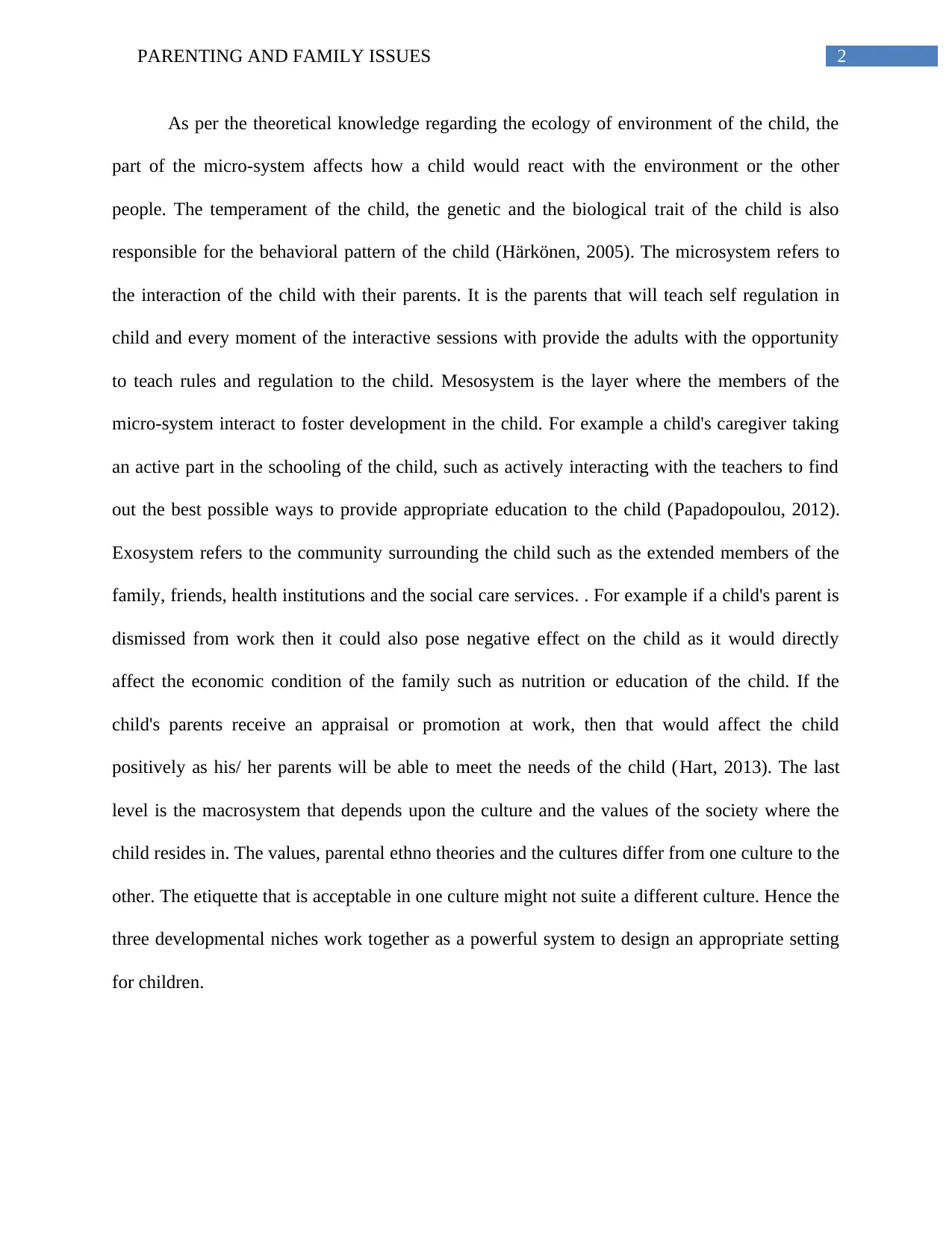
2PARENTING AND FAMILY ISSUES
As per the theoretical knowledge regarding the ecology of environment of the child, the
part of the micro-system affects how a child would react with the environment or the other
people. The temperament of the child, the genetic and the biological trait of the child is also
responsible for the behavioral pattern of the child (Härkönen, 2005). The microsystem refers to
the interaction of the child with their parents. It is the parents that will teach self regulation in
child and every moment of the interactive sessions with provide the adults with the opportunity
to teach rules and regulation to the child. Mesosystem is the layer where the members of the
micro-system interact to foster development in the child. For example a child's caregiver taking
an active part in the schooling of the child, such as actively interacting with the teachers to find
out the best possible ways to provide appropriate education to the child (Papadopoulou, 2012).
Exosystem refers to the community surrounding the child such as the extended members of the
family, friends, health institutions and the social care services. . For example if a child's parent is
dismissed from work then it could also pose negative effect on the child as it would directly
affect the economic condition of the family such as nutrition or education of the child. If the
child's parents receive an appraisal or promotion at work, then that would affect the child
positively as his/ her parents will be able to meet the needs of the child (Hart, 2013). The last
level is the macrosystem that depends upon the culture and the values of the society where the
child resides in. The values, parental ethno theories and the cultures differ from one culture to the
other. The etiquette that is acceptable in one culture might not suite a different culture. Hence the
three developmental niches work together as a powerful system to design an appropriate setting
for children.
As per the theoretical knowledge regarding the ecology of environment of the child, the
part of the micro-system affects how a child would react with the environment or the other
people. The temperament of the child, the genetic and the biological trait of the child is also
responsible for the behavioral pattern of the child (Härkönen, 2005). The microsystem refers to
the interaction of the child with their parents. It is the parents that will teach self regulation in
child and every moment of the interactive sessions with provide the adults with the opportunity
to teach rules and regulation to the child. Mesosystem is the layer where the members of the
micro-system interact to foster development in the child. For example a child's caregiver taking
an active part in the schooling of the child, such as actively interacting with the teachers to find
out the best possible ways to provide appropriate education to the child (Papadopoulou, 2012).
Exosystem refers to the community surrounding the child such as the extended members of the
family, friends, health institutions and the social care services. . For example if a child's parent is
dismissed from work then it could also pose negative effect on the child as it would directly
affect the economic condition of the family such as nutrition or education of the child. If the
child's parents receive an appraisal or promotion at work, then that would affect the child
positively as his/ her parents will be able to meet the needs of the child (Hart, 2013). The last
level is the macrosystem that depends upon the culture and the values of the society where the
child resides in. The values, parental ethno theories and the cultures differ from one culture to the
other. The etiquette that is acceptable in one culture might not suite a different culture. Hence the
three developmental niches work together as a powerful system to design an appropriate setting
for children.
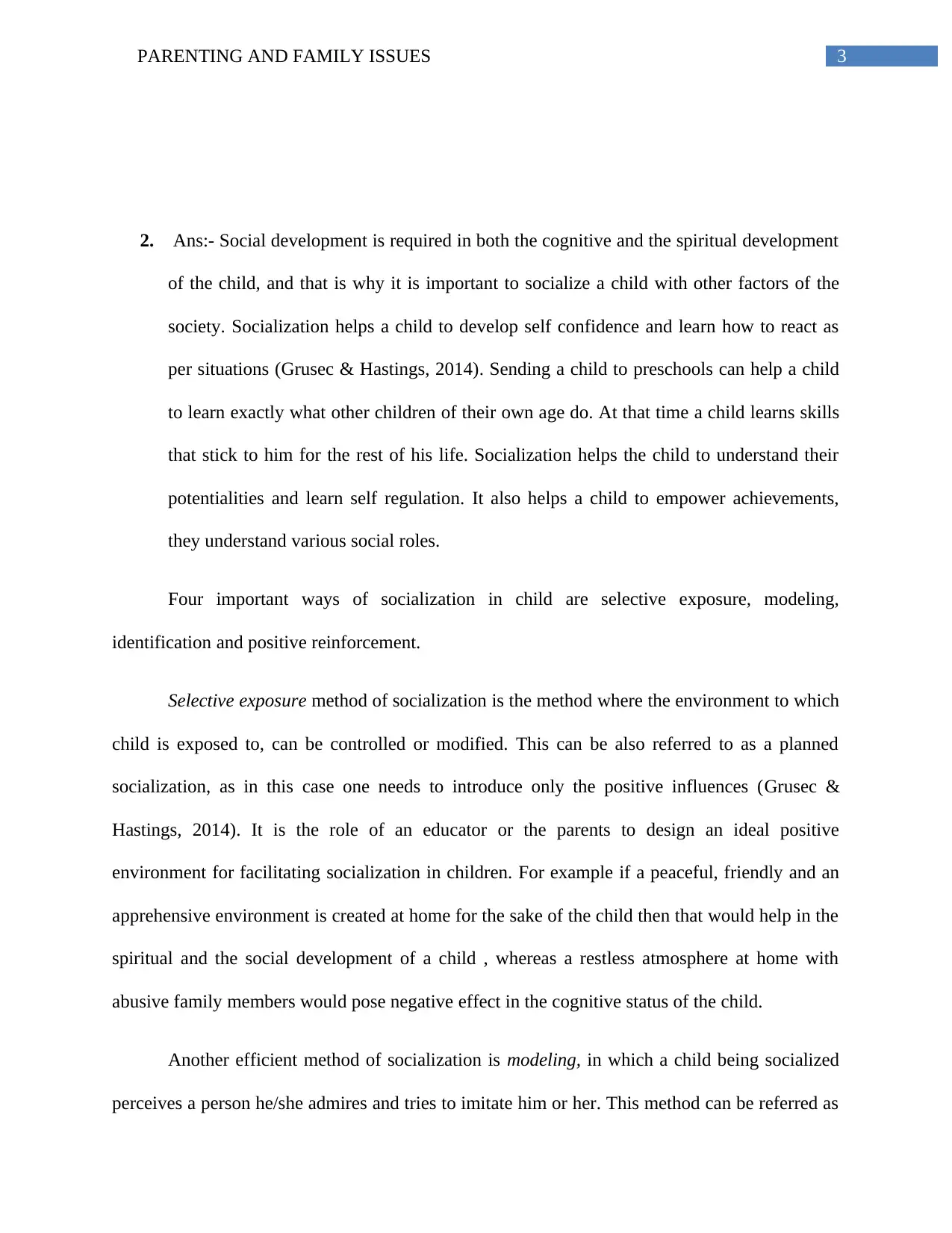
3PARENTING AND FAMILY ISSUES
2. Ans:- Social development is required in both the cognitive and the spiritual development
of the child, and that is why it is important to socialize a child with other factors of the
society. Socialization helps a child to develop self confidence and learn how to react as
per situations (Grusec & Hastings, 2014). Sending a child to preschools can help a child
to learn exactly what other children of their own age do. At that time a child learns skills
that stick to him for the rest of his life. Socialization helps the child to understand their
potentialities and learn self regulation. It also helps a child to empower achievements,
they understand various social roles.
Four important ways of socialization in child are selective exposure, modeling,
identification and positive reinforcement.
Selective exposure method of socialization is the method where the environment to which
child is exposed to, can be controlled or modified. This can be also referred to as a planned
socialization, as in this case one needs to introduce only the positive influences (Grusec &
Hastings, 2014). It is the role of an educator or the parents to design an ideal positive
environment for facilitating socialization in children. For example if a peaceful, friendly and an
apprehensive environment is created at home for the sake of the child then that would help in the
spiritual and the social development of a child , whereas a restless atmosphere at home with
abusive family members would pose negative effect in the cognitive status of the child.
Another efficient method of socialization is modeling, in which a child being socialized
perceives a person he/she admires and tries to imitate him or her. This method can be referred as
2. Ans:- Social development is required in both the cognitive and the spiritual development
of the child, and that is why it is important to socialize a child with other factors of the
society. Socialization helps a child to develop self confidence and learn how to react as
per situations (Grusec & Hastings, 2014). Sending a child to preschools can help a child
to learn exactly what other children of their own age do. At that time a child learns skills
that stick to him for the rest of his life. Socialization helps the child to understand their
potentialities and learn self regulation. It also helps a child to empower achievements,
they understand various social roles.
Four important ways of socialization in child are selective exposure, modeling,
identification and positive reinforcement.
Selective exposure method of socialization is the method where the environment to which
child is exposed to, can be controlled or modified. This can be also referred to as a planned
socialization, as in this case one needs to introduce only the positive influences (Grusec &
Hastings, 2014). It is the role of an educator or the parents to design an ideal positive
environment for facilitating socialization in children. For example if a peaceful, friendly and an
apprehensive environment is created at home for the sake of the child then that would help in the
spiritual and the social development of a child , whereas a restless atmosphere at home with
abusive family members would pose negative effect in the cognitive status of the child.
Another efficient method of socialization is modeling, in which a child being socialized
perceives a person he/she admires and tries to imitate him or her. This method can be referred as
Secure Best Marks with AI Grader
Need help grading? Try our AI Grader for instant feedback on your assignments.
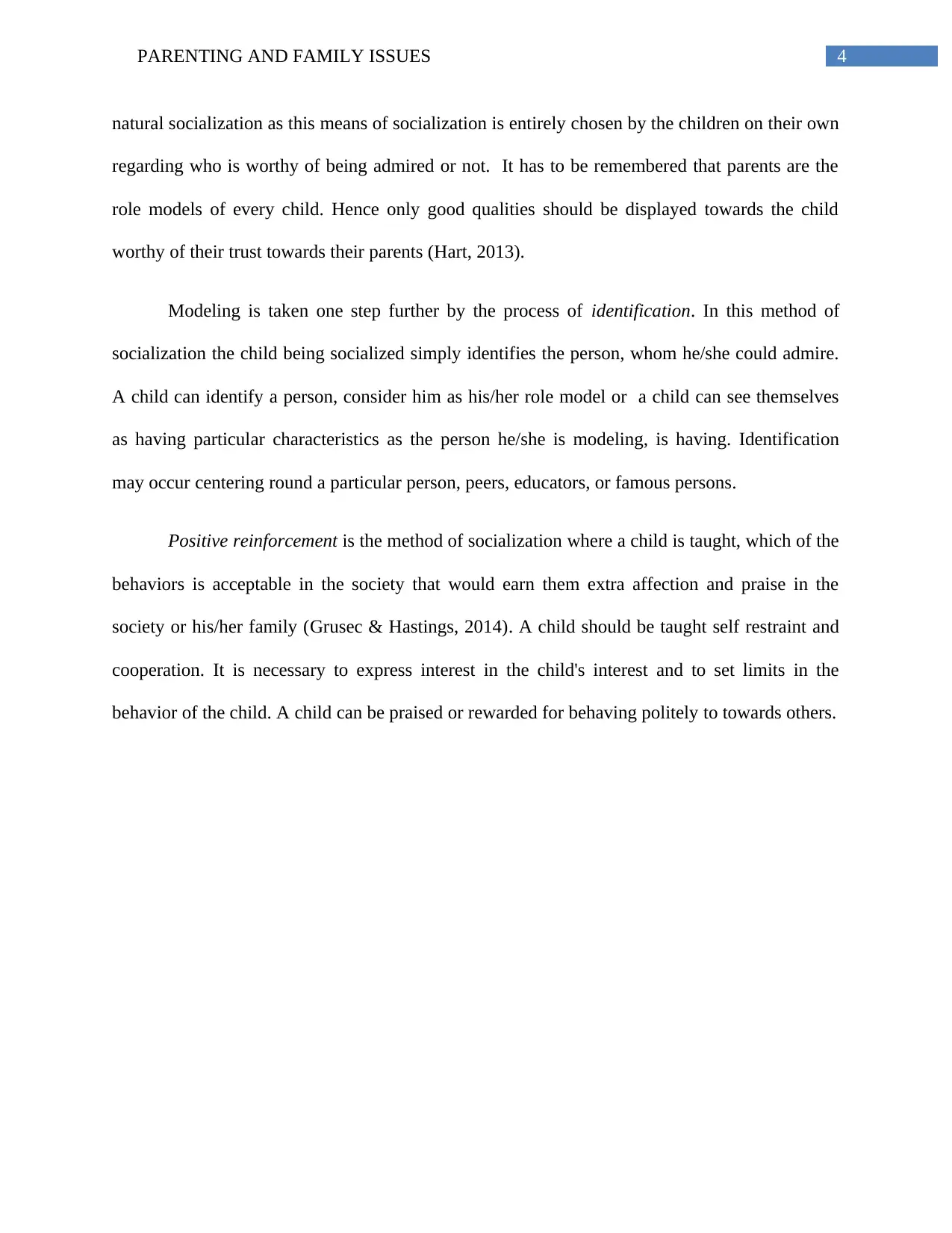
4PARENTING AND FAMILY ISSUES
natural socialization as this means of socialization is entirely chosen by the children on their own
regarding who is worthy of being admired or not. It has to be remembered that parents are the
role models of every child. Hence only good qualities should be displayed towards the child
worthy of their trust towards their parents (Hart, 2013).
Modeling is taken one step further by the process of identification. In this method of
socialization the child being socialized simply identifies the person, whom he/she could admire.
A child can identify a person, consider him as his/her role model or a child can see themselves
as having particular characteristics as the person he/she is modeling, is having. Identification
may occur centering round a particular person, peers, educators, or famous persons.
Positive reinforcement is the method of socialization where a child is taught, which of the
behaviors is acceptable in the society that would earn them extra affection and praise in the
society or his/her family (Grusec & Hastings, 2014). A child should be taught self restraint and
cooperation. It is necessary to express interest in the child's interest and to set limits in the
behavior of the child. A child can be praised or rewarded for behaving politely to towards others.
natural socialization as this means of socialization is entirely chosen by the children on their own
regarding who is worthy of being admired or not. It has to be remembered that parents are the
role models of every child. Hence only good qualities should be displayed towards the child
worthy of their trust towards their parents (Hart, 2013).
Modeling is taken one step further by the process of identification. In this method of
socialization the child being socialized simply identifies the person, whom he/she could admire.
A child can identify a person, consider him as his/her role model or a child can see themselves
as having particular characteristics as the person he/she is modeling, is having. Identification
may occur centering round a particular person, peers, educators, or famous persons.
Positive reinforcement is the method of socialization where a child is taught, which of the
behaviors is acceptable in the society that would earn them extra affection and praise in the
society or his/her family (Grusec & Hastings, 2014). A child should be taught self restraint and
cooperation. It is necessary to express interest in the child's interest and to set limits in the
behavior of the child. A child can be praised or rewarded for behaving politely to towards others.
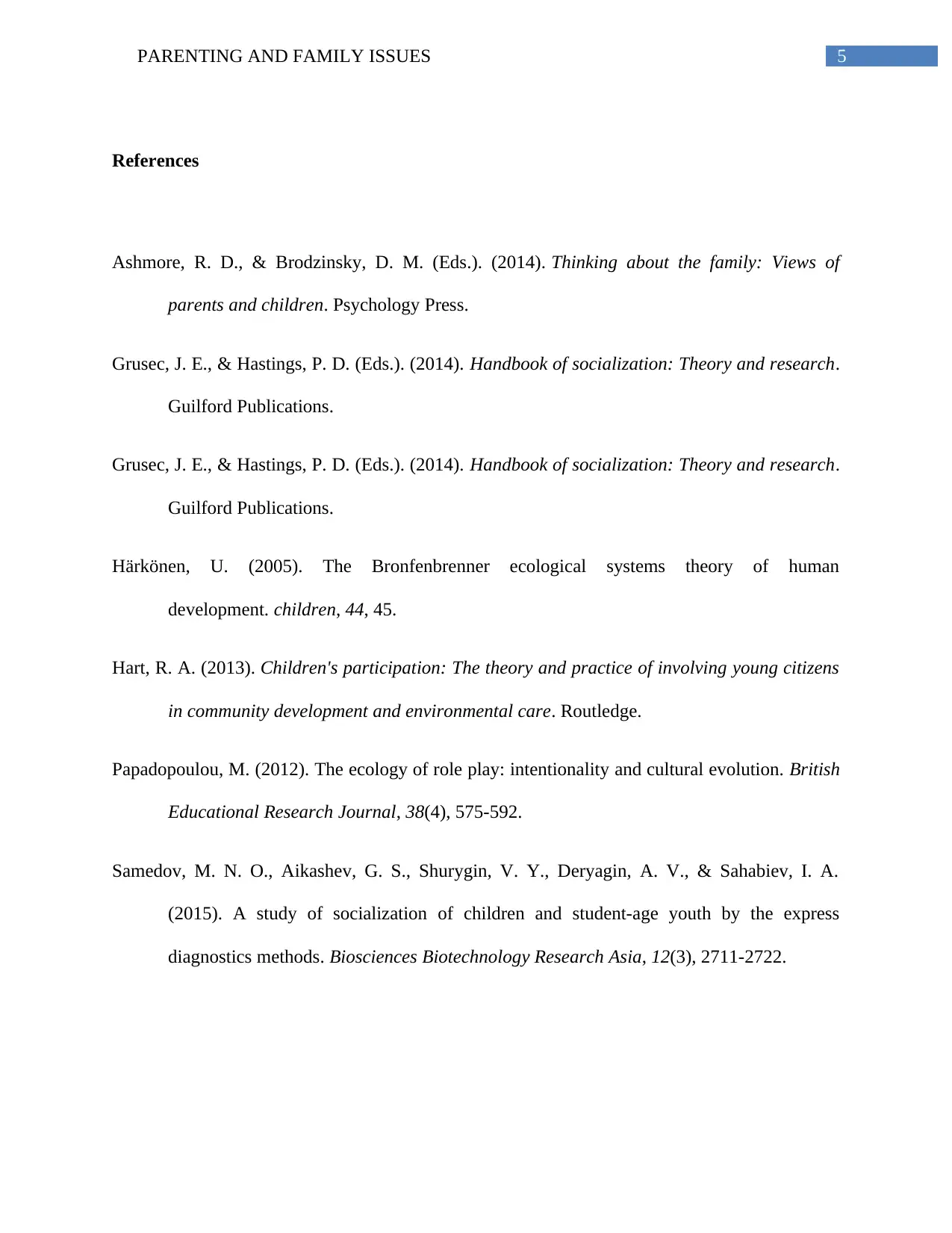
5PARENTING AND FAMILY ISSUES
References
Ashmore, R. D., & Brodzinsky, D. M. (Eds.). (2014). Thinking about the family: Views of
parents and children. Psychology Press.
Grusec, J. E., & Hastings, P. D. (Eds.). (2014). Handbook of socialization: Theory and research.
Guilford Publications.
Grusec, J. E., & Hastings, P. D. (Eds.). (2014). Handbook of socialization: Theory and research.
Guilford Publications.
Härkönen, U. (2005). The Bronfenbrenner ecological systems theory of human
development. children, 44, 45.
Hart, R. A. (2013). Children's participation: The theory and practice of involving young citizens
in community development and environmental care. Routledge.
Papadopoulou, M. (2012). The ecology of role play: intentionality and cultural evolution. British
Educational Research Journal, 38(4), 575-592.
Samedov, M. N. O., Aikashev, G. S., Shurygin, V. Y., Deryagin, A. V., & Sahabiev, I. A.
(2015). A study of socialization of children and student-age youth by the express
diagnostics methods. Biosciences Biotechnology Research Asia, 12(3), 2711-2722.
References
Ashmore, R. D., & Brodzinsky, D. M. (Eds.). (2014). Thinking about the family: Views of
parents and children. Psychology Press.
Grusec, J. E., & Hastings, P. D. (Eds.). (2014). Handbook of socialization: Theory and research.
Guilford Publications.
Grusec, J. E., & Hastings, P. D. (Eds.). (2014). Handbook of socialization: Theory and research.
Guilford Publications.
Härkönen, U. (2005). The Bronfenbrenner ecological systems theory of human
development. children, 44, 45.
Hart, R. A. (2013). Children's participation: The theory and practice of involving young citizens
in community development and environmental care. Routledge.
Papadopoulou, M. (2012). The ecology of role play: intentionality and cultural evolution. British
Educational Research Journal, 38(4), 575-592.
Samedov, M. N. O., Aikashev, G. S., Shurygin, V. Y., Deryagin, A. V., & Sahabiev, I. A.
(2015). A study of socialization of children and student-age youth by the express
diagnostics methods. Biosciences Biotechnology Research Asia, 12(3), 2711-2722.

6PARENTING AND FAMILY ISSUES
1 out of 7
Related Documents
Your All-in-One AI-Powered Toolkit for Academic Success.
+13062052269
info@desklib.com
Available 24*7 on WhatsApp / Email
![[object Object]](/_next/static/media/star-bottom.7253800d.svg)
Unlock your academic potential
© 2024 | Zucol Services PVT LTD | All rights reserved.





